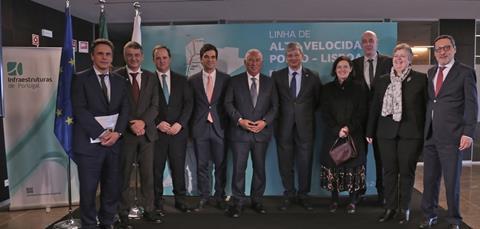
PORTUGAL: Tenders have been called for the starter section of the proposed high speed corridor between Lisboa and Porto.
The first tenders covers Stage 1 between Porto and Oiã near Aveiro. Infrastructure manager Infraestruturas de Portugal held a ceremony at its headquarters at Almada on January 12 attended by Prime Minister António Costa and board members from IP and national operator Comboios de Portugal.
Three stage plan
The Porto – Lisboa high speed programme is to be delivered in three phases.
The first covers the 143 km between Porto and Soure and is expected to cost around €3·7bn, of which €729m is being covered from the EU’s Connecting Europe Facility. This first phase is itself divided into two lots, with the 71 km between Porto and Oiã estimated to cost €1·9bn and the 72 km between Aveiro and Soure put at €1·7bn.
At its northern end, the line would serve Porto Campanhã and Porto’s Vila Nova de Gaia district with an underground station in Santo Ovídio that will be served by the Metro do Porto light rail network. Aveiro and Coimbra stations on the existing north-south main line would be redeveloped to enable high speed services to call; the plans envisage construction of a 17 km link from Aveiro to meet the new alignment at Canelas. In addition, an additional road and rail bridge would be built between Porto and Gaia.
Under current plans, the first section of the new line would be completed by 2028 and the travel time between the country’s two largest cities would be cut from the current 2 h 50 min to less than 2 h.
The second phase between Soure and Carregado near Lisboa has an estimated cost of €1·5bn with completion scheduled for the end of 2030. This element of the scheme would also include quadrupling of the existing railway between Castanheira do Ribatejo and Alverca.
The third phase of the high speed line would be developed between Carregado and Lisboa after 2030, reducing the Porto – Lisboa journey time to 1 h 15 min. Total investment is estimated at €4·5bn.
Broad gauge
The high speed corridor will be double track and built to Iberia’s 1 668 mm gauge. The total planned route length is 290 km and the alignment is being designed for operation at up to 300 km/h.
Development of a new alignment is being mainly driven by capacity constraints on the existing line, which is used by 90% of freight trains moving in Portugal, while around 50% of all CP passenger services use some or all of the route between Porto Campanhã and Lisboa Oriente. IP says the scheme will enable modal shift equivalent to reducing carbon emissions by 5·1 million tonnes by 2060.
The first lot of Stage 1 between Porto and Oiã has already received planning approval from the Portuguese Environment Agency. According to IP, a PPP procurement model is envisaged; five expressions of interest from international consortiums have been received, and formal bids must be lodged by June 13.
The winning bidder will be responsible for the planning, designing, financing, building and maintaining the railway under a 30-year concession. This will give the concessionaire five years for construction and 25 years to manage the new infrastructure. After this period, the assets would revert to government ownership.

















